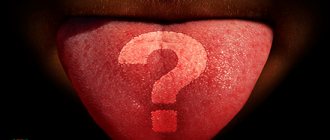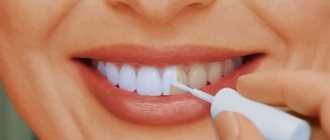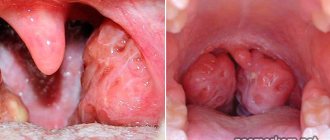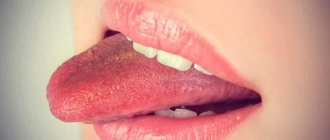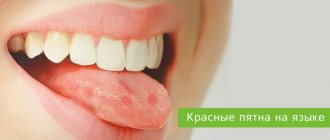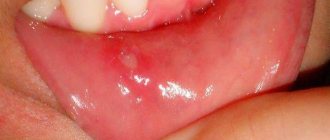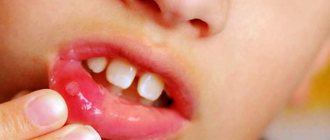How dangerous is smoking for teeth and oral cavity?
Surely you all know that smoking does not have the best effect on enamel.
How exactly? Carcinogens contained in the toxic tars of tobacco smoke accumulate and darkening appears on the enamel. It is very surprising that many smokers are aware of how smoking affects the teeth and oral cavity, but still turn a blind eye to it. Allegedly, whiten your teeth at any time by contacting a professional dentist.
Condition of teeth in a smoker
The dentition of a smoker has characteristic changes that occur with prolonged use of cigarettes in large quantities:
- Formation of tartar containing tobacco combustion products in large quantities.
- The gums become looser, which leads to the gradual progressive formation of periodontal pockets. Food debris accumulates in these cavities, increasing the risk of developing an infectious process.
- The effect of smoking on teeth is the severe destruction of enamel, which begins with microscopic damage and ends with deep cracks.
- Gradual destruction of the tooth from the inside. In advanced cases, pieces may break off when chewing solid food.
- Reducing the size of crowns and expanding the distances between them due to sedimentation of the mucous membrane. Gradual loosening of teeth followed by their loss.
Gradual damage to the dentofacial apparatus progresses and spreads beyond the oral cavity, affecting the larynx.
Smoking causes tartar to form on teeth.
Smokers cannot avoid the appearance of dark plaque on their teeth . To remove tartar, you will have to contact specialists in any case, since it will not be possible to remove it yourself. And for some time the tartar will indeed disappear, but only for some time. After half a year or a year, the cleaning procedure will have to be repeated again. If you overuse this type of cleaning, you can even lose a tooth. We all know that the danger of tartar is that in addition to bad breath, it can cause inflammation of the gums, in some cases they can begin to bleed. If you neglect it and do not pay attention to tartar, periodontitis .
How to remove plaque in the dentist's office?
The dentist has many effective ways to remove plaque from smoking. Many people believe that they need to whiten their teeth right away. But first, the doctor will offer you professional hygiene, which necessarily includes plaque removal using ultrasound or an Air-flow device. It is designed to remove soft microbial plaque and tartar using a mixture of abrasive, oxygen and water. This composition knocks down deposits on the enamel, polishes it and helps prevent the development of caries and other infectious and inflammatory diseases.
And only after the stone has been removed can teeth whitening be carried out. This will be the final stage of getting rid of yellow or brown plaque, which is particularly corrosive.
There are several ways to professionally whiten teeth while smoking:
- the use of laser systems to lighten enamel;
- trays with whitening gel for office and home use;
- ZOOM teeth whitening using a special gel and LED lamp.
You can consolidate the result with the help of professional whitening pastes. In the first days after enamel lightening, it is prohibited to consume coloring foods and drinks: coffee, strong tea, wine, beets, sweet carbonated drinks.
It is also recommended to pay increased attention to the quality of personal hygiene. If you brush your teeth poorly, neglect flossing, irrigators, and rinses, then if you smoke, the whitening effect will last only for a few months.
Methods for whitening teeth while smoking at home
If you are unable or unwilling to visit a dentist, you can get rid of plaque from smoking using home methods. But their effectiveness is much lower than professional methods of whitening and removing plaque.
Basic rules and methods for removing smoker’s plaque from teeth:
- If the enamel color is yellow or brown, but there is no solid stone, you can use special home systems to lighten the enamel. They must be applied with a brush or placed in a tray. They decompose the coloring pigment. But if used incorrectly, they can cause irritation of the gums and increased sensitivity of the enamel.
- As an alternative to whitening trays, lightening strips are used. Most often they are used to whiten teeth that are part of the smile area.
- A proven and affordable option for gradually lightening enamel is brushing your teeth with soda. It acts as a soft abrasive and removes not only microbial film, but also dense plaque. Baking soda can be added to toothpaste or used in its pure form. The duration of such bleaching is no more than 7-17 days (no more than 2-3 times a week). If tooth sensitivity increases while using baking soda, you should stop using it.
- Teeth whitening with lemon juice. This method is quite aggressive, as it causes increased sensitivity of the enamel in many people. Lemon juice is applied to the brush with toothpaste in a small amount.
- Use of activated carbon. The method is effective for minor yellowing of the enamel. Activated carbon needs to be turned into powder and used to brush your teeth.
- Use of hydrogen peroxide. The product can be used as a home antiseptic. Peroxide contains atomic oxygen, which effectively destroys pathogenic microorganisms and suppresses the growth of unhealthy microflora.
- Removing plaque after smoking with tea tree oil. It has antiseptic and light whitening properties. Tea tree oil does not irritate the oral mucosa and has a negative effect on cariogenic microorganisms.
To reduce the rate of plaque formation when smoking, it is recommended to brush your teeth or use mouthwash immediately after smoking a cigarette. This will remove most of the tar and nicotine that form the corrosive yellow and brown plaque on the teeth.
Detailed description of teeth whitening with soda
To whiten your teeth by smoking you will need a small amount of baking soda, toothpaste, a toothbrush and some water. You can use several options for lightening the enamel. The first of them involves treating the teeth with a damp brush and dry soda. The second option requires you to first wet the brush and mix baking soda with a small amount of water to a paste-like mixture. This composition is what you need to brush your teeth with.
Contraindications for home enamel lightening using soda:
- increased sensitivity of teeth;
- bleeding gums;
- pronounced carious process;
- exacerbation of any infectious and inflammatory diseases of the oral cavity;
- enamel hypoplasia.
Baking soda can be used to maintain the whitening effect after professional dental procedures. But remember the contraindications and the importance of taking breaks in use. You should not brush your teeth with baking soda every day because of the risk of damaging your teeth and causing inflammation of your gums.
Prevention
If the predisposing factors are not eliminated and the quality of oral care is not improved, plaque from smoking will form again and again. Prevention should be regular. At the initial stage, plaque is soft and can be easily removed with a toothbrush and paste. But over time, it hardens and turns into stone, which cannot be removed at home. The more plaque there is, the higher the risk of developing caries and other dental diseases.
Try to reduce the number of cigarettes you smoke.
You can completely give up a bad habit only gradually, after realizing the harmful effects of smoking on the body. If you have complaints about your oral health, contact your dentist in a timely manner and treat any identified pathologies. This will allow you to keep your teeth beautiful for a long time without resorting to prosthetics and implantation. To get a consultation
How smoking interferes with blood flow
It has been proven that smoking has a detrimental effect on blood vessels, they can narrow and blood circulation in the vessels themselves can be disrupted. What are the dangers of lack of oxygen and lack of nutrients? All of the above can develop atrophy of the oral mucosa. At the first stage of development a smoker's gums become inflamed , and the inflammation is accompanied by redness, swelling and bleeding , the name of all this is gingivitis. Over time, periodontal tissues become inflamed, and ultimately, a person is doomed to lose a tooth - in medicine it is called chronic periodontitis.
Preventive actions
The most effective prevention of pathological changes is giving up the bad habit. If this is not possible, then the following recommendations will help reduce the destructive effects of tobacco smoke:
- Careful, daily personal hygiene. It is recommended to brush your teeth after each meal, use dental floss, and mouthwash.
- Preventive examinations at the dentist with professional cleaning, including whitening. You need to visit a doctor 1-2 times a year to remove tartar and plaque and identify inflammation and infection in the early stages.
- If you cannot completely quit smoking, then you need to at least reduce the number of cigarettes you smoke per day. We are talking not only about the condition of the mouth, but also the impact on the entire body as a whole.
Since to restore teeth after smoking , you should choose a trusted clinic. Dentistry "Nurimed" offers services for whitening, removal, restoration, prosthetics and other types of oral treatment for smokers. The center’s specialists will help you regain psychological comfort and physical health, lost due to the effects of smoking on your teeth.
If you smoke, think about whether you should quit smoking? Moreover, smoking is not fashionable now.
Let us once again note the main negative consequences of smoking for teeth and the oral cavity as a whole:
- Smoking causes teeth to darken
- Smoking causes bad breath
- Smoking causes gum disease
- A person who smokes can lose teeth
- Smoking can cause complications in the treatment of dental diseases
- Smoking causes mucosal
Why do smokers get toothache?
The destructive effect on tooth enamel leads to toothache from smoking . The mechanism of pain is associated with several factors:
- increased overall sensitivity due to thinning of the enamel;
- inflammation of the gums due to the penetration of bacteria;
- development of pulpitis (inflammation affecting the root).
Increased sensitivity leads to the fact that a person feels pain when eating foods that are too cold or hot, sweet, sour, or overly spicy foods. Gradually, the situation worsens, then any impact on the damaged enamel begins to cause pain.
Causes of harmful effects of tobacco smoke
When smoking cigarettes, heated smoke from tobacco enters the smoker's body. It contains:
- nicotine;
- monoxide ;
- resinous components;
- hydrocyanic acid;
- methane;
- other elements containing in much less consistency.
High temperatures cause damage to tooth enamel, which manifests itself in the form of microcracks. Substances contained in cigarette smoke irritate the oral mucosa and destroy beneficial microflora that prevent the penetration and proliferation of pathogenic microorganisms.
Effect on gums
Due to the narrowing of the vessels of the upper and lower jaw, blood supply deteriorates. Outwardly, this is manifested by changes in the color of the gums: they become pale pink. Plaque is also found on the mucous membrane.
Typical diseases of smokers are: caries, pulpitis. Even more complex situations will develop when inflammatory processes penetrate the bone tissue of the jaw. Poor nutrition and blood supply to the gums leads to tooth loss.
Destructive processes in teeth occur under the influence of:
- carbon monoxide;
- hydrocyanic acid;
- resins;
- methane;
- nicotine
Professional whitening
If you can’t get rid of the unsightly plaque at home, you need to see a dentist. Modern technologies make it possible to permanently remove ugly pigment. This can be accomplished by professional cleaning using mechanical and ultrasonic devices. Using abrasive cleaning and polishing, you can not only give the enamel its original whiteness, but also prevent further plaque formation. Of course, this is true when a person stops smoking.
If professional cleaning does not bring the desired result, resort to enamel whitening. There are many contraindications to this procedure, so only a dentist can prescribe it.
In some cases, you can clean the enamel using a combined method. First, the plaque is softened with a special chemical component, and its remains are removed with specialized equipment. After this, the teeth are ground, polished and coated with preparations containing fluoride.
After I quit smoking, my teeth turned about 2 shades yellower. At the same time, every evening I brush my teeth, and in the morning I wake up and there is a yellow coating on my teeth, I brush my teeth again, my teeth become a little clearer, in the evening I brush again and in the morning it’s the same story! At the same time, in my life I have never changed my wife, my job, my house, my car, my food, my water (the composition of the water in my house is constant), or my toothpaste. In general, everything except the toothbrush, which I replaced with a new one. I went to the dentist - my teeth are in excellent condition, I don’t know the reasons for the yellowing! Then I did an experiment - I didn’t specifically brush my teeth in the evening and smoked one cigar (small cigars) without puffing, and in the morning. Miraculously, my teeth turned white and the yellow plaque disappeared! After which, only on the second day (in the morning) a yellow coating appeared again. Everything I described here is true. I don't know the reasons! The desire to quit smoking is strong, after this experiment I did not take a cigar for more than 3 months. and there is no desire to start smoking.
If anyone knows the reason, write! After all, it exists, it’s not nonsense, but an interesting fact!
What diseases can plaque cause?
If in the early stages of smoking the appearance of plaque only visually worsens the condition of the dentition , then over time this habit can lead to more serious consequences.
develop :
- caries;
- chronic gum bleeding;
- gingivitis;
- periodontal disease;
- periodontitis.
According to statistics, smokers completely lose healthy teeth by the age of 65 .
Note! If we compare them with non-smoking people, then this indicator is 2 times higher.
Clinical trials
Clinical studies have proven that regular use of professional toothpaste ASEPTA COFFEE AND TOBACCO for a month improved the hydration of the mucous membrane by 3.3 times, the remineralizing efficiency increased by 3.9 times, at the same time, the cleansing effect has increasing dynamics and reaches 60 .5% at 4 weeks of use.
Sources:
- Report on determining/confirming the preventive properties of toothpaste “ASEPTA PLUS” COFFEE and TOBACCO Author: doctor-researcher A.A. Leontyev, head Department of Preventive Dentistry, Doctor of Medical Sciences, Professor S.B. Ulitovsky. First St. Petersburg State Medical University named after. acad. I.P. Pavlova, Department of Preventive Dentistry
- Report on determining/confirming the preventive properties of toothpaste “ASEPTA PLUS” GENTLE WHITENING” Author: doctor-researcher A.A. Leontyev, head Department of Preventive Dentistry, Doctor of Medical Sciences, Professor S.B. Ulitovsky First St. Petersburg State Medical University named after. acad. I.P. Pavlova, Department of Preventive Dentistry
- Clinical and laboratory assessment of the influence of domestic therapeutic and prophylactic toothpaste based on plant extracts on the condition of the oral cavity in patients with simple marginal gingivitis. Doctor of Medical Sciences, Professor Elovikova T.M.1, Candidate of Chemical Sciences, Associate Professor Ermishina E.Yu. 2, Doctor of Technical Sciences Associate Professor Belokonova N.A. 2 Department of Therapeutic Dentistry USMU1, Department of General Chemistry USMU2
- Report on the determination/confirmation of the preventive properties of personal oral hygiene products “ASEPTA PLUS” Remineralization doctor-researcher A.A. Leontyev, head Department of Preventive Dentistry, Doctor of Medical Sciences, Professor S.B. Ulitovsky First St. Petersburg State Medical University named after. acad. I.P. Pavlova, Department of Preventive Dentistry
- Clinical studies of antisensitive toothpaste “Asepta Sensitive” (A.A. Leontyev, O.V. Kalinina, S.B. Ulitovsky) A.A. LEONTIEV, dentist O.V. KALININA, dentist S.B. ULITOVSKY, Doctor of Medical Sciences, Prof. Department of Therapeutic Dentistry, St. Petersburg State Medical University named after. acad. I.P. Pavlova
- The role of anti-inflammatory rinse in the treatment of periodontal diseases (L.Yu. Orekhova, A.A. Leontyev, S.B. Ulitovsky) L.Yu. OREKHOVA, Doctor of Medical Sciences, Prof., Head of Department; A.A. LEONTIEV, dentist; S.B. ULITOVSKY, Doctor of Medical Sciences, Prof. Department of Therapeutic Dentistry of St. Petersburg State Medical University named after. acad. I. P. Pavlova
